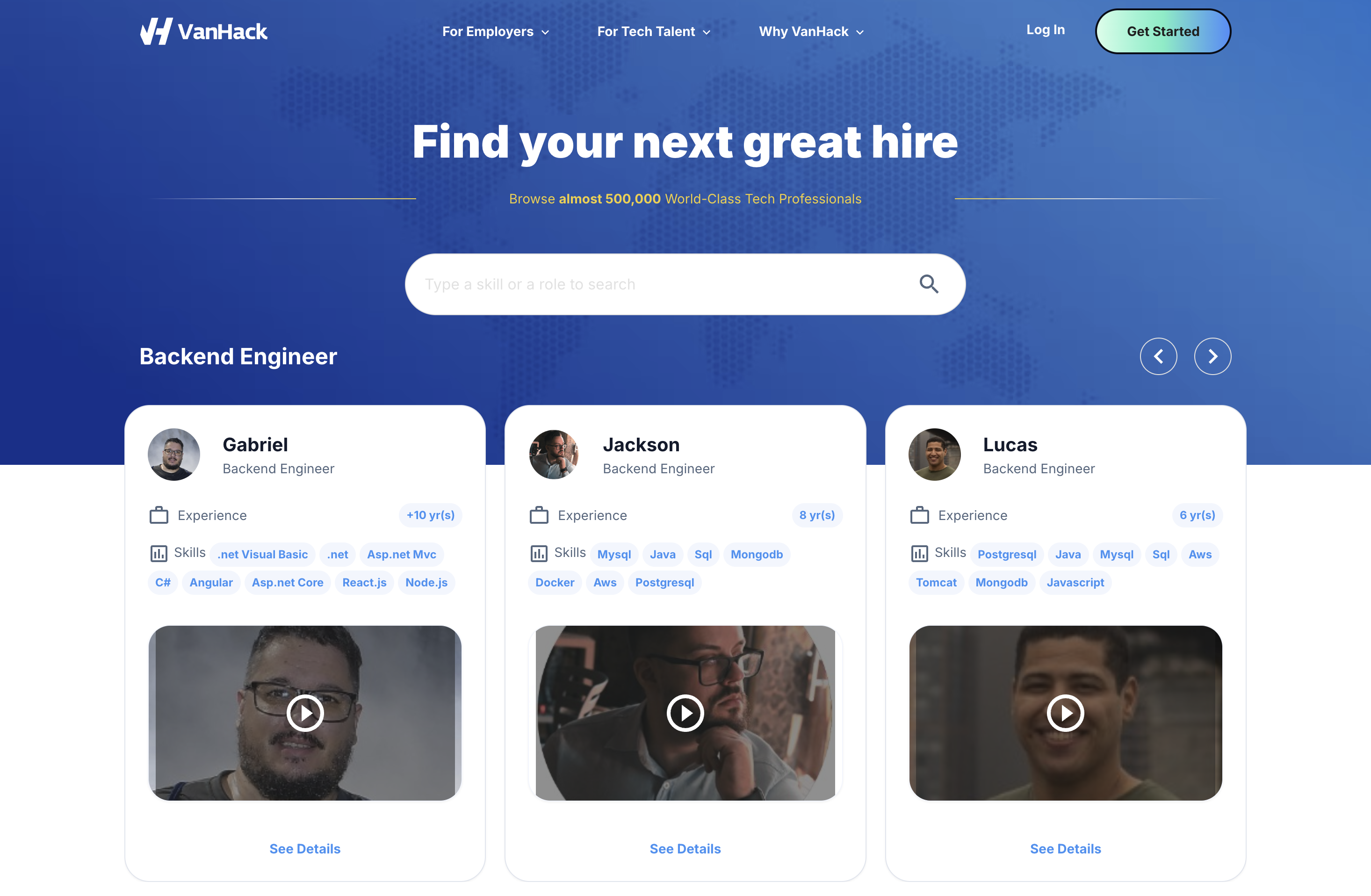Building engineering teams is now a critical strategy for US companies aiming to boost product development speed and stay competitive. Domestic hiring often falls short due to limited talent pools, long hiring times, and high costs. This guide breaks down practical workforce planning strategies and global hiring tips to help you create strong, distributed engineering teams with remote LATAM developers. If you’re looking to scale efficiently, hire top talent faster with VanHack and tap into Latin America’s skilled tech community.
Modern Workforce Planning for Global Talent
Core Concepts in Global Hiring Strategies
Grasping the basics of global workforce planning helps you make informed decisions for hiring. Talent acquisition goes beyond filling roles. It involves long-term planning, strengthening your employer brand, and creating pipelines for growth, especially in international markets where cultural understanding and relationships are key.
Seniority levels in engineering vary globally. Senior developers, with 5 to 7 years of experience, tackle complex issues and system design. Staff engineers, with 8 to 10 years, guide technical strategy and mentorship. Principal engineers, with over 10 years, shape architectural decisions and organizational impact. In LATAM, experience often outweighs job titles due to unique career paths.
Compensation for global hires isn’t just about salary. LATAM developers often prioritize equity, learning opportunities, remote work benefits, and career growth over small pay raises. Tailoring offers to these preferences can boost acceptance rates.
Integrating International Engineering Teams
Evaluating candidates for remote roles requires looking at collaboration skills, communication in asynchronous settings, and cultural adaptability, alongside technical expertise. Focus on their problem-solving methods, coding standards, and system design skills rather than specific tools or algorithms.
Cultural fit in global hiring means seeking unique perspectives that align with your company’s values. LATAM talent often brings collaborative styles and solid technical skills, adding value to diverse teams.
For startups, global hiring poses challenges like time zone management, remote onboarding, and team unity. Setting up clear protocols for decision-making, documentation, and communication helps distributed teams work smoothly.
Should You Build or Buy Talent Acquisition?
Deciding whether to develop in-house hiring capabilities or partner with platforms is a key step in workforce planning. Building internally gives control but requires heavy investment in expertise, compliance, and market connections, often suiting companies hiring over 20 international staff yearly.
Partnering with external platforms offers quick access to talent networks, vetting processes, and legal know-how without the initial setup cost. Solutions like VanHack provide technical assessments and cultural evaluations that take years to build internally.
A mixed approach, combining internal teams for local hiring with external partners for global sourcing and compliance, often works best for balancing control and efficiency.
Cost Benefits of Hiring Remote LATAM Developers in 2025
Hiring remote LATAM developers offers clear financial upsides in 2025. In the US, senior developers earn around $11,000 monthly, or $132,000 yearly, while similar talent in LATAM earns $3,600 to $4,700 monthly, or $43,200 to $56,400 yearly, saving 60 to 70% on costs for the same skills.
These savings grow with team size. Hiring one US senior developer costs as much as a small LATAM engineering team, letting you expand capabilities within budget limits.
Additional savings come from lower benefits, recruitment, and compliance costs. Expenses for these areas in LATAM are significantly less than in the US, while productivity remains on par with local hires.
Even with market shifts, LATAM talent stays cost-effective. Despite 8 to 15% salary rises in 2025, senior LATAM developers still cost 30 to 40% of US equivalents, maintaining strong budget advantages.
Why LATAM Offers Untapped Engineering Talent
Shifts in the Global Talent Market
Over the past five years, the engineering talent market has changed dramatically. Big Tech firms dominate domestic senior talent with high pay packages small companies can’t match. Meanwhile, consulting firms and niche agencies compete for remaining talent, driving up costs.
Remote work has removed location barriers, opening access to markets like LATAM. Developers there often have strong English skills, time zones close to the US, and solid technical training, making them a great fit for US companies.
Trends show growth in specialized hiring platforms, technical community involvement, and the need for unique employer branding. Companies adapting to these shifts gain a lasting edge in finding talent.
Limits of Traditional Hiring for Global Growth
Old-school hiring methods, like job boards or referrals, don’t work well for global talent. Platforms like LinkedIn bring in tons of applications but lack filters for international hires, creating a time-intensive review process with little quality gain.
Referrals are great for cultural fit but often stay within existing team networks, missing out on new regions like LATAM where current staff may lack connections.
General recruitment agencies often lack the specific skills for global hiring, such as cultural assessments, technical evaluations, or compliance knowledge for markets like LATAM, limiting their impact.
Emerging Ways to Access Global Talent
Top companies are moving beyond standard recruiting by connecting with international tech communities, joining global developer events, and building thought leadership in target regions.
Employer branding now highlights remote work options, learning opportunities, and career paths over just salary. LATAM developers value companies with true remote setups, skill growth, and clear advancement routes.
Engaging with tech communities through open-source projects, events, and content creation builds trust and visibility abroad. Companies doing this create stronger talent pipelines than those sticking to traditional hiring.
Key Steps in Global Workforce Planning
Choosing Between Internal Teams or External Partners
Building an internal global hiring team means investing in expertise, market knowledge, and systems. Full-time international recruiters cost $80,000 to $120,000 yearly, plus benefits and tools for compliance and assessments.
External partners offer ready-made networks, vetting, and legal support without upfront costs. Platforms with success-based fees align costs with hiring goals, reducing financial risk.
For companies hiring under 15 international staff yearly, external partnerships often deliver better value. For larger needs, a hybrid model with internal coordination and external support balances cost and control.
Managing Resources for Distributed Teams
Global hiring affects company structure, communication, and management styles. Prepare for asynchronous work, cultural blending, and remote performance tracking by training managers and updating processes.
Technology for remote teams, like video tools and secure access, costs $500 to $1,500 per employee yearly but boosts productivity when done right.
Cultural integration needs ongoing effort. Set up mentorship, orientation, and team-building to connect diverse staff. This directly improves retention and performance.
Tracking Success in Global Hiring
Measuring global hiring success goes beyond time-to-fill. Look at 90-day performance, project impact, and team integration to gauge hire quality.
LATAM developers often reach full productivity in 60 to 90 days due to cultural alignment and time zone overlap, faster than many other regions.
Retention rates show hiring and integration effectiveness. Companies with strong LATAM integration see over 90% retention in year one, compared to 75 to 80% for US hires in tight markets.
Calculate total hiring costs, including platform fees and onboarding. Global hires often save 40 to 60% compared to local options while delivering similar results.
VanHack: Your Partner for Hiring LATAM Developers
VanHack helps US companies tap into LATAM’s top developer talent with a focused approach. Combining technology, market knowledge, and proven methods, they offer better results than traditional hiring. Here’s a look at the platform:

Cost-Effective Hiring with an “All You Can Hire” Model
VanHack’s “Vanna” subscription offers unlimited hiring for a flat $3,000 monthly fee, reshaping recruitment costs. Traditional agencies charge 15 to 25% of a hire’s yearly salary, often $12,000 to $20,000 per senior developer at $80,000 annually.
For growing teams, VanHack cuts acquisition costs by 70 to 80%, letting you hire multiple roles under one fee while speeding up team expansion.
This fixed cost aids budget planning, allowing scaling based on business needs, not recruiting limits. Begin hiring with VanHack for a smarter way to grow your team.
Thorough Vetting and Detailed Candidate Profiles
VanHack’s multi-step vetting delivers shortlists of 3 to 5 qualified candidates, cutting through the noise of unqualified job board applications. Their process blends AI matching, technical reviews, and cultural checks for quality.
Video intros let managers gauge communication and fit upfront, saving time before deeper interviews, especially crucial for global hires.
AI-driven technical interviews via Ripples offer 30-minute recorded sessions with transcripts and scores, showing problem-solving and clarity without live scheduling.
Coding test results from Woven add hard data on skills and benchmarks, streamlining technical screening for better decisions with less effort.
Optional Global Mobility Support
For companies relocating talent, VanHack’s Global Mobility team handles visas, immigration advice worth about $5,000, and logistics like housing and schools.
This service suits roles requiring in-person work, expanding your talent options while keeping remote flexibility open for later.
Post-relocation, local VanHacker WhatsApp groups connect new hires to peers, easing adjustment and supporting early productivity.
Direct Hires with Community Backing
VanHack connects companies directly with candidates for employment, avoiding ongoing middleman fees. This cuts costs and ensures hires get full benefits and growth paths.
Direct hiring simplifies compliance, IP protection, and integration, giving companies full control over terms and management.
Post-hire, VanHack’s community of placed professionals offers mentorship and cultural tips, boosting retention and team blending.
VanHack vs. Other Hiring Options
|
Feature |
VanHack |
Traditional Agencies |
Job Boards |
|
Cost Model |
Flat-Fee/Success |
15-25% of Salary |
Posting Fees |
|
Candidate Vetting |
Deep, Multi-Stage |
Variable Quality |
Self-Reported |
|
Global Mobility |
Full Service |
None |
None |
|
Technical Assessment |
AI-Powered + Tests |
Basic Screening |
Resume Only |
This table shows VanHack’s clear edge for US companies hiring LATAM talent, with cost savings and complete services that outpace traditional methods.
Are You Ready to Hire Remote LATAM Talent?
Checking Your Global Hiring Readiness
International hiring success depends on your company’s processes, cultural openness, and tech setup. Assess your readiness honestly to ensure smooth integration and retention.
Review your hiring workflows, documentation, and performance systems. Companies with structured domestic processes adapt better to global needs than those with informal setups.
Gauge cultural readiness by looking at leadership support for diversity, team openness to remote work, and flexibility in communication styles. Strong adaptability leads to better outcomes.
Ensure tech readiness with secure remote tools, collaboration software, and project systems. These basics directly affect global hire productivity.
Identifying Key Roles and Stakeholders
Global hiring needs clear stakeholder roles and job prioritization based on business needs. Decision-makers like CTOs and engineering leads should define technical and team needs.
Find internal champions with remote work or global experience to push for cultural shifts and adoption of new hiring practices.
Prioritize roles with defined metrics and integration potential, like senior individual contributors, for high impact with low management overhead.
Start with one or two key hires to refine processes and cultural blending before scaling up global hiring efforts.
Planning Partnerships and Timelines
Evaluate internal skills versus external expertise for hiring partnerships. Assess your team’s experience in global recruitment, technical screening, and compliance to find gaps.
Account for extra time in global hiring, adding 2 to 4 weeks for vetting, integration, and potential visa needs compared to local timelines.
Align hiring with product cycles, expansion plans, and budgets to ensure new hires add value without disrupting team flow.
Plan for risks like cultural clashes or compliance issues. Choosing the right partner and preparing upfront cuts these challenges significantly.
Avoiding Common Mistakes in Global Hiring
Even experienced teams face hurdles in international hiring. Knowing these pitfalls helps you address them early for better results.
- Cultural integration often gets overlooked. Focus on orientation, mentorship, and ongoing support to bridge gaps, not just technical skills.
- Underestimating legal and compliance issues risks delays. Global hiring involves varied laws and tax rules needing expert input.
- Standard tech assessments miss remote skills like self-management and async communication. Adapt evaluations for distributed roles.
- Unclear communication rules across time zones cause friction. Define meeting needs, response times, and documentation early.
- Misaligned pay with local markets wastes budget or loses talent. Understand regional norms while keeping internal fairness.
- Weak tech setup for remote teams slows hires. Invest in tools and access before onboarding for immediate impact.
- Domestic management styles don’t always fit global teams. Update evaluations and career paths for remote staff.
These issues can be dodged with careful planning and the right partner. Find skilled LATAM developers with VanHack and sidestep these errors with expert support.
Key Questions on Hiring Remote LATAM Developers
What’s the 2025 Salary Range for Senior LATAM Developers?
In 2025, senior LATAM developers earn about $54,000 yearly on average, varying by country, specialty, and experience. Mexico averages $46,300, Colombia slightly less, Costa Rica around $52,500, and Panama near $49,600.
Specialties like AI, cloud, and mobile development push earnings higher. Full-stack and backend roles hit median ranges, while frontend may earn less based on tools.
Experience within seniority tiers matters. Those with 5 to 7 years earn lower in their region’s range, while 8 to 10 years or leadership roles command more.
How Do Costs Compare Between LATAM and US Talent?
Hiring LATAM talent saves significantly over US developers. US senior roles exceed $132,000 yearly, while LATAM equivalents range from $43,200 to $56,400, cutting costs by 60 to 70% for similar expertise.
Total costs, including benefits adding 25 to 40% in the US, are lower for LATAM hires, even with competitive packages, maintaining high retention.
Recruitment fees for US talent via agencies hit $15,000 to $25,000 per hire, while platforms like VanHack offer access to vetted LATAM talent at lower costs.
For scale, hiring 2 to 3 LATAM seniors matches the cost of one US developer, expanding capacity without budget strain.
What Are the Advantages of Using VanHack for LATAM Hiring?
Platforms like VanHack streamline LATAM hiring over traditional methods. They deliver shortlists of 3 to 5 pre-vetted candidates, saving time versus sorting through job board floods.
Hiring timelines shrink from 8 to 12 weeks with standard methods to 4 to 6 weeks, thanks to ready networks and efficient workflows.
Cost savings stand out with a flat monthly fee for unlimited hires, cutting expenses by 70 to 80% compared to agency fees of 15 to 25% per role.
Compliance and mobility support ease legal and relocation hurdles, crucial for companies new to global hiring, reducing risks and complexity.
Established processes and ongoing candidate relationships lower turnover and integration issues, improving hiring success.
How Can US Companies Integrate LATAM Developers Successfully?
Integrating LATAM remote developers needs focus on communication, culture, and growth. Set clear rules for response times, meetings, and documentation to handle time zone differences effectively.
Offer cultural orientation to explain US business norms while learning LATAM work styles, fostering mutual understanding and team unity.
Invest in professional growth with training, conferences, and career paths to show commitment, boosting long-term retention.
Align pay with local markets while keeping internal balance. Research benchmarks and add benefits like flexibility to attract top talent.
Ensure tech tools support remote work with secure systems and collaboration platforms, avoiding barriers to productivity.
How Do Time Zones Affect Collaboration with LATAM Teams?
LATAM time zones, within 1 to 3 hours of US times, ease collaboration compared to Asia or Europe. This overlap supports daily check-ins and real-time problem-solving.
Schedule key meetings during shared hours while respecting personal time, allowing non-urgent tasks outside overlap for continuous progress.
Strengthen asynchronous communication with clear documentation and decision rules, cutting meeting overload while keeping teams aligned.
Consider cultural preferences in scheduling. Some LATAM teams value personal connection, others efficiency, so tailor approaches for best results.
Conclusion: Streamline Hiring with VanHack
Workforce planning for engineering now demands global strategies to access cost savings, skills, and diversity. US companies adapting to this gain an edge by hiring LATAM developers, cutting costs by 60 to 70% with matching quality and time zone benefits.
Success in global hiring requires cultural integration, solid remote processes, and partnerships with platforms that handle complexities. Picking the right ally is vital to avoid setbacks.
VanHack offers a complete solution for tapping LATAM talent, with AI matching, deep vetting, affordable pricing, and mobility support. Their approach ensures strong hires and integration.
As tech needs grow and US talent competition tightens, building global hiring skills now sets you up for lasting success. Ready to enhance your team? Start hiring with VanHack today and build a high-performing global workforce.



